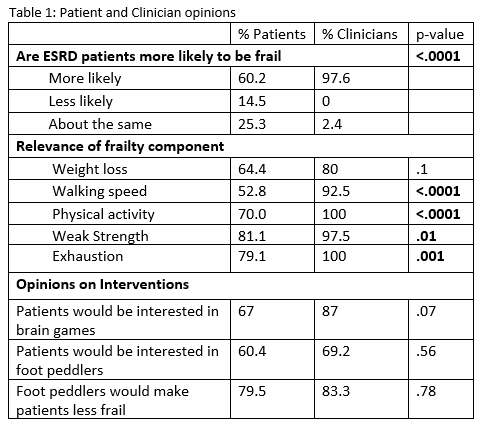Engaging Clinicians and Patients Regarding Frailty Assessment in Kidney Transplant Candidates.
JHU, Baltimore
Meeting: 2017 American Transplant Congress
Abstract number: C60
Keywords: Kidney transplantation
Session Information
Session Name: Poster Session C: Disparity in Access and Outcomes for Solid Organ Transplantation
Session Type: Poster Session
Date: Monday, May 1, 2017
Session Time: 6:00pm-7:00pm
 Presentation Time: 6:00pm-7:00pm
Presentation Time: 6:00pm-7:00pm
Location: Hall D1
Background: The Fried frailty phenotype, a measure of physiologic reserve, is associated with poor kidney transplant (KT) outcomes. However, it was developed in community-dwelling older adults and might not be ideal for KT assessment. Some Fried components may not apply to KT patients, and some ESRD-specific aspects of frailty may not be captured in the Fried phenotype. Examining existing and identifying novel components are necessary to characterize frailty and tailor interventions among pre-KT patients.
Methods: We elicited opinions on frailty from clinicians treating KT candidates (nephrologists, transplant surgeons and gerontologists) at JHU in a 2-round consensus-building Delphi study (round 1 n=41; round 2 n=36; response rate 87%) and from 91 KT candidates (response rate 97%).
Results: Clinicians were more likely than patients to say ESRD makes patients frail (p=<0.001 Table 1); older patients were less likely than younger patients to say ESRD makes patients frail (p=0.01). 3.3% of patients self-identified as frail; 19.3% measured as frail. 3.3% of patients have been told their frailty status; 61.8% of patients want to be told. Clinicians agreed on what constitutes frailty in ESRD patients. Clinicians were more likely to say that 4/5 frailty components were relevant to ESRD patients (Table 2). Clinicians identified 10 new ESRD-specific frailty components. Gerontologists were less likely to want to add cognition and history of falls (Table 2). Clinicians and patients agreed that patients would be interested in interventions, and that foot-peddlers would make ESRD patients less frail (Table 1).
 Conclusions: Opinions on frailty in KT candidates differed between patients and clinicians, but all agreed that KT candidates would be interested in interventions that could improve frailty in this population.
Conclusions: Opinions on frailty in KT candidates differed between patients and clinicians, but all agreed that KT candidates would be interested in interventions that could improve frailty in this population.
CITATION INFORMATION: Rasmussen S, Konel J, Ying H, Haugen C, King E, DiBrito S, Segev D, McAdams DeMarco M. Engaging Clinicians and Patients Regarding Frailty Assessment in Kidney Transplant Candidates. Am J Transplant. 2017;17 (suppl 3).
To cite this abstract in AMA style:
Rasmussen S, Konel J, Ying H, Haugen C, King E, DiBrito S, Segev D, DeMarco MMcAdams. Engaging Clinicians and Patients Regarding Frailty Assessment in Kidney Transplant Candidates. [abstract]. Am J Transplant. 2017; 17 (suppl 3). https://atcmeetingabstracts.com/abstract/engaging-clinicians-and-patients-regarding-frailty-assessment-in-kidney-transplant-candidates/. Accessed January 5, 2026.« Back to 2017 American Transplant Congress
